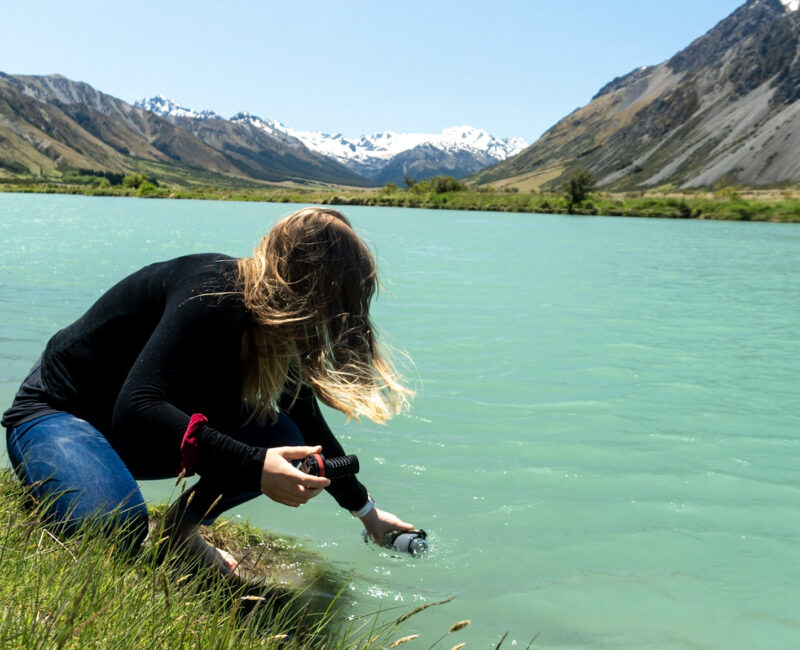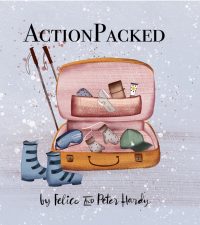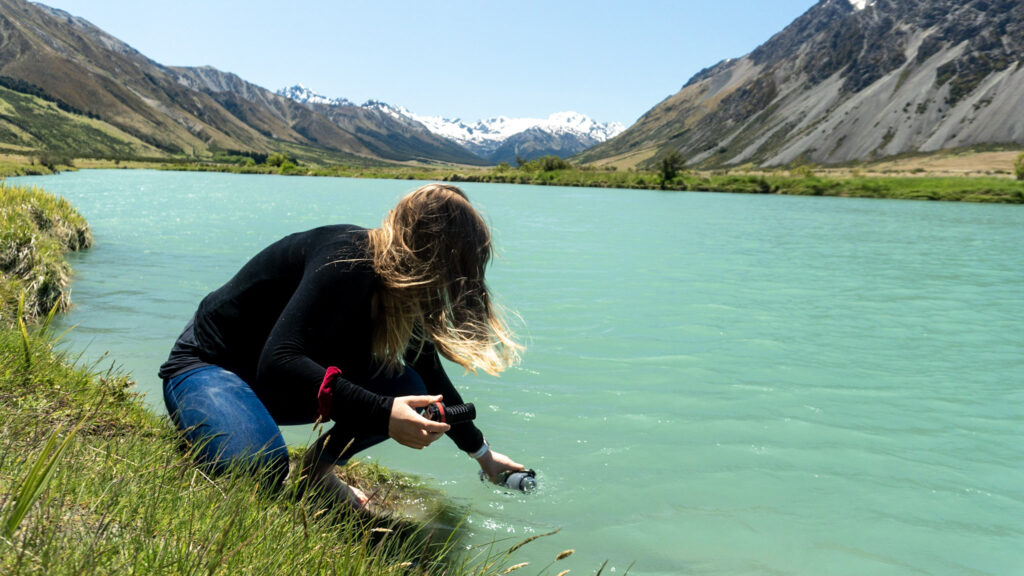
Peter Welcome to our travel podcast, we’re specialist travel writers and we’ve spent half a lifetime exploring every corner of the world.
Felice So we want to share with you some of our extraordinary experiences and the amazing people we’ve met along the way.
Peter Everyone should be able to drink safely. And we’re not talking here about beer, wine, margaritas, mojitos or whatever is your favourite tipple. We’re talking about Adam’s Ale: good old H2O. Back in 2002, the United Nations adopted water as a basic human right. But sadly, the fact is that millions still don’t have easy access to clean drinking water. Anyone who’s a world traveller, be a backpacker or a five-star hotel guest, will know the debilitating consequences: Delhi Belly, Montezuma’s Revenge or in more extreme cases, dysentery, typhus, and all kinds of other horrible life-threatening diseases that are waterborne.
Felice So imagine if someone were to invent a handy water bottle, filtering out all these horrors and much more? Imagine if you could fill your bottle from the most polluted stretch of the Ganges in India or even from the bowl of a public loo in Shanghai or Nairobi – or London or New York for that matter, and then instantly turn the disgusting contents into safe, odour-free H2O.
Peter Amazingly, this is no pipe dream. Such high-tech bottles with a triple-action filter are manufactured by a British company called Water-to-Go. They’ve been tried and tested in all those places and more by grateful travellers around the globe over the past 10 years. So we went along to meet founder, Dave Shanks, whose HQ is a farmyard in rural Hertfordshire, 30 miles north of London. Incidentally, the tap water around here is loaded with chlorine and Dave won’t touch it unless he’s filtered it first. Stay with us and we’ll try to give you a 15% discount code for buying your own Water To Go bottle.
Felice Dave, welcome to our travel podcast. You invented something quite remarkable, potentially life-changing, for millions of people around the world. So how did Water-to-Go first come about?
Dave Well, I was in the garment business. I used to travel the world – to India, China, Hong Kong, Indonesia, Mauritius for manufacturing and textiles. So we used to have our own fashion labels, but we also used to supply a lot of the high street and, being fairly well known in the business, quite a few retailers would ask me to vet factories and check out on what I thought, how they were performing, how eco-friendly they were, the manufacturing environment. And one particular trip, I went via India to China and I don’t know what particularly twigged that particular trip, but in just everywhere I was looking, all the factories, were just loads and loads of single-use plastic water bottles.
The first thing you do when you go into a factory in China, they give you half a dozen bottles of water to make sure you’re hydrated. It’s almost like a respect thing. And I just basically saw that none of this was being recycled. I then went down to Indonesia where the situation was even worse. My last stop on the trip was Mauritius, and I had to vet a knitwear factory for a high street retailer here in the UK. And that particular factory was just the straw that broke the camel’s back really. Six hundred machinists on the factory floor at the time, each shift getting a third of a litre single-use plastic water bottle, all with the factory’s branding. He thought he was doing a really good job.

Dave with some of his bottles
So all of the girls were hydrated. It was a completely female-run factory, which for the client I was working with was a very, very positive thing. But at the end of the day, when we did an audit of what they were doing with the discarded dying waters from dying knitwear, we went to the back of the factory and it was a great big lake of effluence, absolutely rank. All of that dye stuff was just poured into this particular lake at the back. And all of the single-use plastic water bottles were dumped in the same lake. Not quite sure what one person can do, but I thought I’d give it my best shot.
Went back to the hotel bar that evening, was sitting having a drink, travelling on my own. And I asked the barman for a gin and tonic and a glass of water. And he said: ‘What’s the water for?’ And I said ‘For drinking?’ He said: ‘I’m sorry, you can’t have it for drinking. It’s not filtered.’ So at that stage, I realised it was not only the single-use plastic water bottles that were the problem, but also it’s the whole question about access to and the quality of the drinking water you actually can put into the bottle in the first place.
So spent a lot of time researching new types of plastic, because ultimately I’m one of the few people on the planet that actually thinks plastic is good – it’s lightweight, it’s durable, and if we treat it with respect, we can use plastic to our benefit. We did a lot of research and found that in the States that we’re developing all of these BPA-free, reusable, recyclable plastics. And then we started doing work on filters and we came up with the concept of a multi-layered filter, which would do more than one job.
And basically we found that NASA had charged some American professors and scientists to develop something which could do the job of a domestic filter like your Brita at home, making the water taste and smell better – an industrial filter which would remove chemicals and things like pesticides – an outdoor filter which was challenged to try and take out microbiological contaminants. And we heard about that technology, we took the base concept of that and developed it to the filter we have at the moment, which basically does all those three jobs and even takes out viruses.
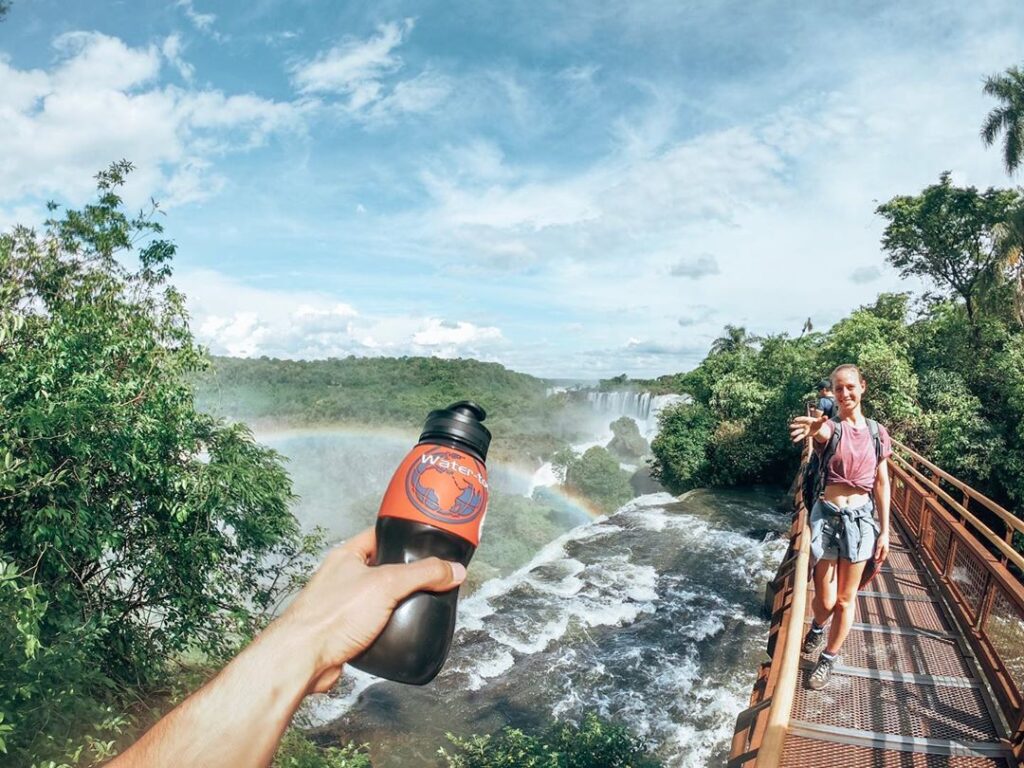
Peter Can you filter out coronavirus?
Dave Coronavirus isn’t actually something waterborne; it’s in the droplets. If it was in a glass of water, yes, we would. I mean, we filter out typhus, cholera, hepatitis out oft the water. London School of Hygiene & Tropical Medicine have us filtering over 99.9% of polio virus, which at the time was the smallest virus known to man. So you know, we can filter out viruses. We’ve been very careful not to play on it. I would hate anybody to think that we were capitalising on the pandemic. But yes, we do filter viruses.
Felice So basically, you can fill up the bottle in a river or a pond or anywhere?
Dave Yes, literally anywhere. The only thing our filters can’t filter is salt water. But you can take water from any non-store source. We’ve got people who have trying directly out of the Ganges. One of our really famous ambassadors, Ash Dykes, first human to walk the entire length of the Yangtze River in China, drew water out of the Yangtze all the way down…even when he was in Shanghai. We’ve had people in Lombok after the earthquakes, drinking water from puddles. You can take any water at all, any tap in any standpipe, any river, any stream. And there is on YouTube, a video of me picking up water from a puddle on St Albans High Street. It works. I got in trouble with the policeman for creating a bit of a traffic jam because all the cars were stopping looking at me. It did work.
Felice So what if the water’s got dye in it, like you mentioned, the factory you went to?
Dave Yes. I mean, basically we take out all chemical types as well. Take out the worst things – faecal coliforms in human debris and or take out all of that. The normal question is, do your filter pee? Yes, we do, but I wouldn’t recommend it. And it will take out faecal coliforms. It’ll take out heavy metals, things like iron, and let the water take chlorine fluoride. We took raw well water directly from a village in India. And we took out things like naturally-occurring arsenic to over 92%. And there isn’t a hand-held filter on the planet that is better than that. Ian Botham used the bottles in Sri Lanka on his…he did a walk to highlight the plight of issues with cadmium, naturally-occurring cadmium in the tap water out there. So a lot of the school-age children have got stomach ulcers as a result of the cadmium. We take out cadmium, so it’s a fantastic technology.
Felice How do you know how long will a filter last fall?
Dave Well, we have at the moment two different sizes of bottles. We’ve got a 50 centilitre bottle, which has a 130-litre filter, and we’ve got a 75 centilitre bottle – two versions of that – which have 200-litre filters. But what we do, I mentioned earlier that some people like Brita simply improve the taste and smell of the water. Well, we’ve taken that one step further. That’s done by putting activated carbon into the filter. Basically activated carbon will improve the taste and smell. And most carbon block filters, where the carbon is actually melted into a mountain of bubbles into a block, a lot of the actual surface of that filter is only the glue that holds the carbon together. In our filter, the activated carbon is loose within the membrane so it’s 100% efficient. So we’ll do a much, much better job of taking out chlorine and fluoride, and improving the taste and smell.
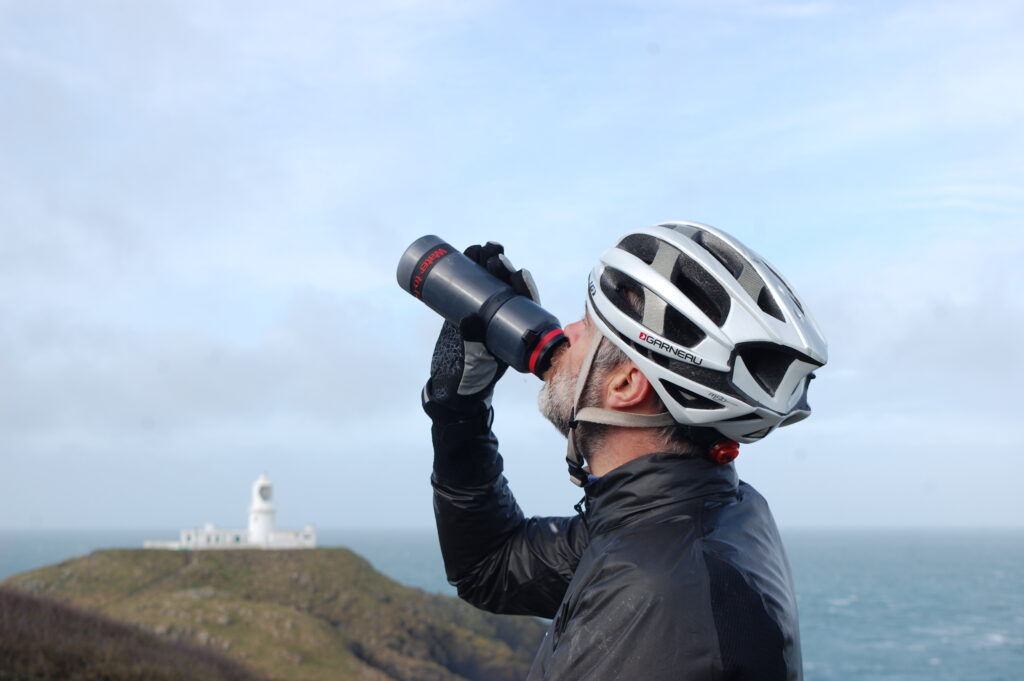
Dave But we programme into the filter just enough carbon – for example, on the large filter, the 200 litres – to last 200 litres. Although the other two technologies – there are three technologies in the filter – the technologies do the really heavy work and to take out chemicals and viruses and bacteria, whatever, they will protect you up to about 225, 230 litres. At the end of 200 litres, the activated carbon – as your Brita filter – starts to lose its strength. As it does so, the water will start to taste and smell as if it’s not being filtered. So that your sensory prompt, if you like. Not really dissimilar from what you do with with the milk before you put it into a cup of tea…you taste or smell it. And if at any stage the water tastes or smells in any way odd, that’s when you change your filter and in ours, on the small filter it’s about 130 litres, on the big filter 200 litres. So the filter itself will tell you when you need to change yours.
Peter That’s pretty remarkable.
Felice So are you likely to make a bigger one that people can have in their household?
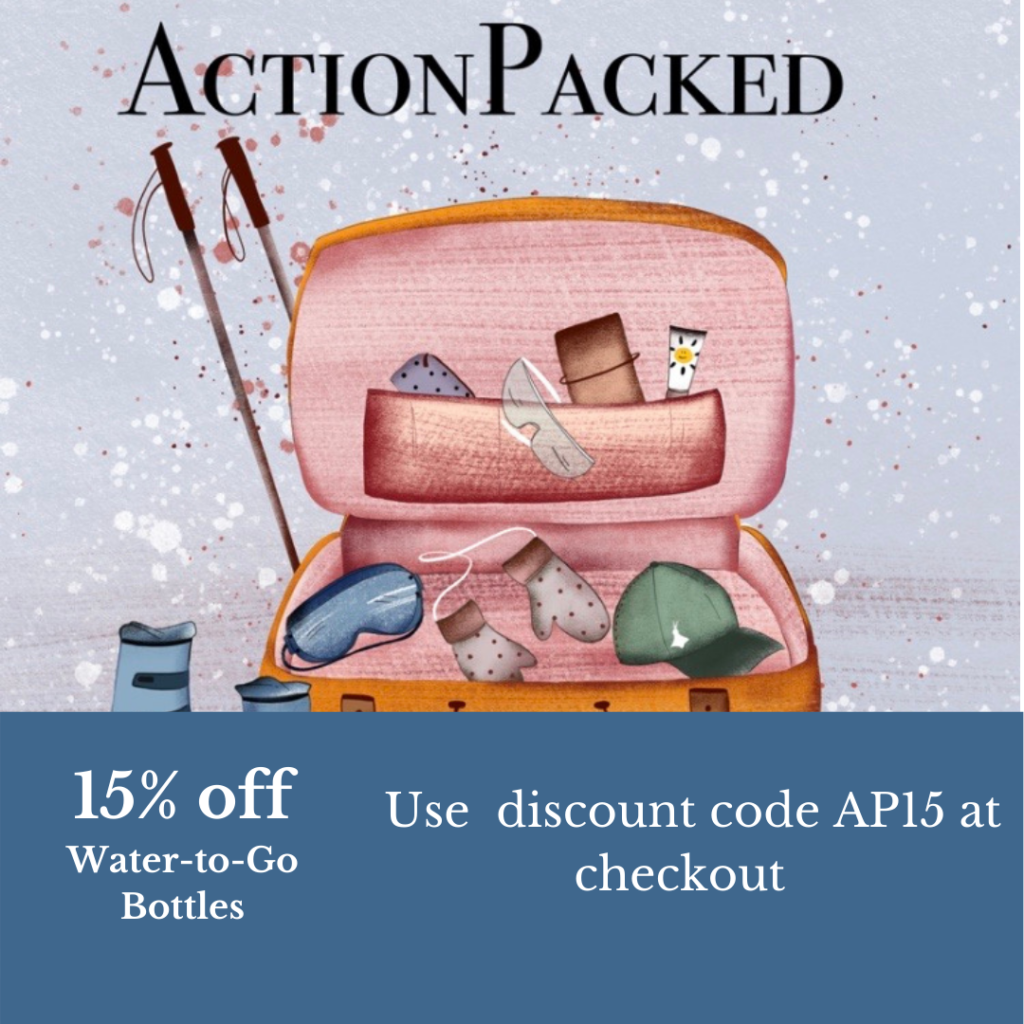
Dave My major response to that is a big smile, because that was very much on the drawing table, pre-Covid. We are actually working at the moment on a three and a half litre table-top jug, which will not only do for the household market, but for camping and caravanning as well. And obviously, when we do start to travel again, it will work for the markets further afield as well. So if you’re going on safari, one of the big problems with the lodges is people don’t trust the water quality. Some of the nicer ones you don’t want to have big bottles on the table. So we’re looking at that market.
Peter Ok, so he a great special offer for all of our listeners at Action Packed when buying Water To Go bottles online. When you go to check out on either of these two websites, Watertogousa.com or Watertogo.eu – just add our special code: AP15 – Action Packed 15 – into the box marked ‘coupon’ and you get 15% of the total of whatever you spend. Either of the websites. That’s for anyone living in the USA, UK and elsewhere in Europe. Remember the code: AP15. The company’s catchphrase is: ‘Making dirty water drinkable’ and these bottles do just that.
Felice I wondered if you knew how many plastic bottles people threw away. Is that a known figure?
Dave Well, I can’t answer that directly, but we know that if one of our filters, the larger filter, would replace 400 standard 50-centilitre bottles, the Evian/Vittel, that type of size. And given the fact we’ve been in business for 10 years, we estimate and you can’t always guarantee that every filter purchase is used for the full duration and I’m not quite sure about repeat, but we’ve saved over a million bottles now…single-use plastic water bottles, just based on the number of filters we’ve sold.
Peter Are you the only company which produces this?
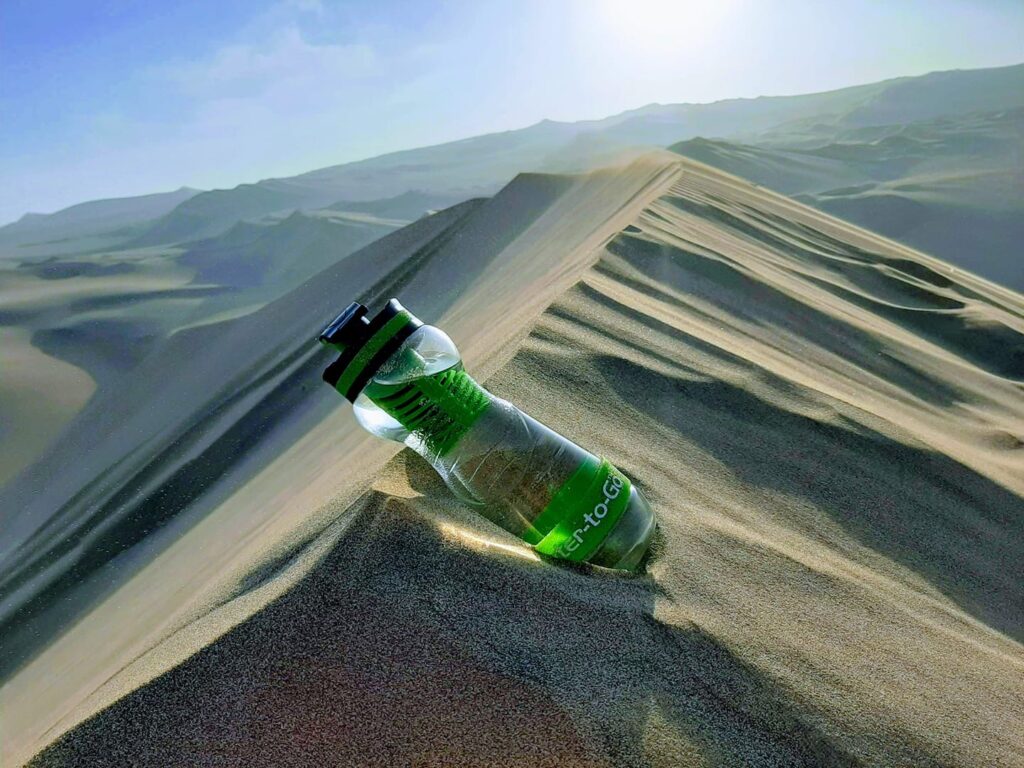
Dave There are competitors in the marketplace now. When I first set the business up, what I wanted to do was to make our technology accessible – so it’s still under £30 retail for the large bottles and £15 each for the smaller bottles. Because nobody offers a technology like ours, we are head and shoulders above in terms of filtration compared to the competition, and nobody delivers a price per litre. So, for example, if you’re buying a repeat filter off us or off a retailer, to get a filter they work out £10. So for 200 litres it works out at five pence per litre.
Felice So Dave, what is it actually in tap water – somewhere like the UK or the USA – that needs filtering out?
Dave Ok. Well, basically, it depends on your taste. Both markets have chlorine in the water. I live in Hertfordshire and about once every two or three weeks, water will come through the tap in the house, a milky white, and that’s because they’ve loaded the tap water with chlorine to kill off any bugs or it has been an outbreak of bugs. Fluoride is another one. Specific parts of the UK: West Midlands and Wales in particular have very, very heavily fluoridated water.
In addition to that, there are trace elements like lead and iron in the water, and some people don’t like those. So then there is simply the question of taste, how the water tastes when it comes out of the tap. You can probably tell from my accent, I’m originally from the Northeast and I remember water coming out of the tap tasting fantastic, if a little like irony. But the tap water in Hertfordshire I just basically won’t drink; I can taste the chemicals.
And actually, once you’ve drank water using a water bottle with the filter and then you go back to non-filtered water, you can taste the chemicals in it. It’s really that obvious. I mean, we’re blessed, I must admit, we’re blessed in most of Europe with reasonable tap water. But there again, there are outbreaks, there are chemicals in them which people dislike. And that’s when we use the filters to filter tap water.
Peter Now, you started the company 10 years ago and you’ve grown and grown and grown. How many countries are you in now?
Dave We’re actually physically represented with distributors in 54 countries – that covers all of Europe, with the exception of Finland and the Baltic states. We are quite strong now in China as a big market, turning on to both aspects of our business and actually filtering and making safe tap water. But the second strain is obviously the environment and saving the environment, stopping single-use plastic water bottles and all the impact with pollution.
And that is, believe it or not, growing in relevance in China. So in China, Macao, Taiwan and Hong Kong now, and just pre-Covid we launched in the USA, Canada, re-launched in Mexico, and then we’ve also launched in Australia and New Zealand. So from very humble beginnings and a small start, we’ve got a good covering across the world. I would like to do more specifically in the developing market, but that’s part and parcel of the long-term goal of the business, to be able to make our technology more accessible.
Peter You say everyone has the right to have clean water. And you seem to be the answer to this. In remote corners of Africa, in India, you can actually produce clean water quite simply and quite cheaply.

Dave Yes we can, Peter. Well, when we spoke earlier, we said about five pence per litre, if not in certain circumstances, that the price of the bottle is prohibitive. So the mission statement of the business is basically ‘get our technology into the hands of the people who need it on a day-to-day basis.’ And the way we do that is twofold. One, we will create a good commercial platform in the developed world, which will get us up to critical mass in terms of manufacturing. We manufacture all of our own filters to secret recipes, but we make our own filters and the more we can make, obviously, the more efficient we become and the better the prices become. And that will help in one respect.
But when we look at the developing world, places like the Indian subcontinent, huge swathes of Africa and Latin America, we’re looking for partners there who – with the right partner we will give them the manufacturing rights to the bottle, to the silicon branding and to the packaging – that should make them eligible for tax breaks, local job creation. And by then simply shipping the technology, which is the lid and the filter, of which we can ship a damn site more – quantity-wise – and the same size of cartons as we can do shipping bottles around the world. That will mean freight is much cheaper per unit, import duties reduce, and that should give us a far more competitively-priced product to get it into the hands of people who need it. And in a lot of cases that will be via governments, NGOs and charities. We know that.
We’re already working with the UN, a lot of their peacekeepers are using the bottles, in fact two new sets of peacekeepers are going out this month on new mission statements. The difficulty with that is obviously people see them using the bottles and having this clean drinking water. We do a lot of work with charities like Just a Drop as well – supporting them to make sure that they’re putting in larger-scale water filtration programmes. That’s a key thing we’ve involved in. The mission statement is basically to get the technology to the people who need it on the day-to-day basis. We’re 10 years down the road, still a long way to go. And hence my concentration on launching the product into new marketplaces, because that will give us that critical commercial foundation and platform to build a business and be able to do what we want to do long term.
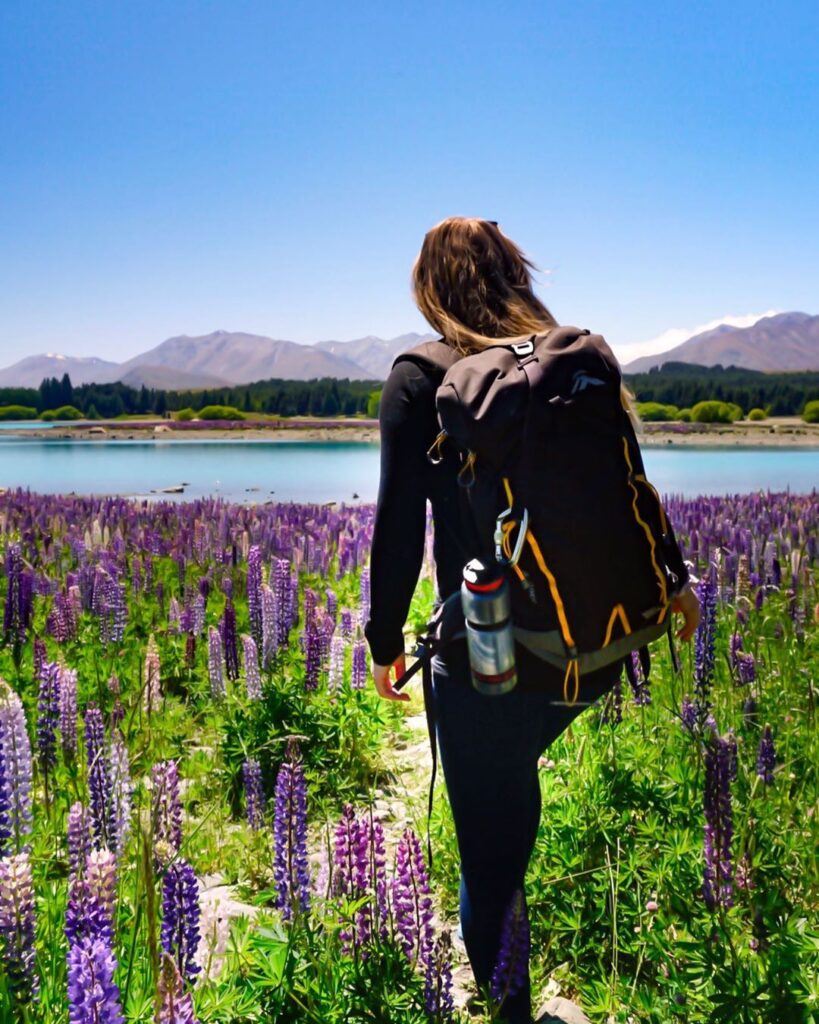
Peter So where do you see Water To Go in, say, five years’ time?
Dave I would like to see Water To Go in five years’ time with a large investor party coming in, and to really make it a global brand. What I can do with my own purse strings and persuading friends, family and fools to come in and support us. No, we’ve got a very, very tight community of people supporting the brand so far. There is a limit to what you can do. It’s a private enterprise. And I would like one of the big international corporations or, you know, like with Bill Gates or something like that, to look at the technology we’ve developed and come up with a 20-year plan. We work in line with the U.N. sustainability goals but we could really do with a major, major partner coming in to help us grow the brand.
Felice I’m sure you’ll find one.
Dave Well, we hope so, Felice. It’s always difficult, because when you look at it from the perspective…this has been very much my baby type thing, and we’re growing and we’ve got some really keen people. The new team in the States, the team in Oceania, Australia, New Zealand, the guys in China – they’re really, really pushing this forward at a pace. Demand for different types of product, demand for bigger upscaling products to tackle different things. And there’s a limit to which I can respond to that, given the financial constraints of being a small business.
Peter But to how many bottle do you manufacture per year?
Dave To give you an idea, last year we were probably in the region a quarter of a million, I would say. But that’s where I say we need to grow the business. I’m not hungry to be a millionaire or anything like that; I’m hungry to get this technology out. It’s that old Dragons’ Den question-mark: how much of the equity to give away for an investment and what do they bring to the table?
Peter Our podcast goes out to, I think, 49 different countries around the world. I’m sure there’s someone out there, some entrepreneur, someone working for a major corporation, who says ‘this is extraordinary, let’s help.’
Dave That would be super. The job’s not done yet.
Peter We’ve known about it in our family for most of your nine years, I should think, because our children are inveterate explorers and they wouldn’t go anywhere without your bottles. So it’s nice to meet the man who invented them.
Dave That’s very nice of you. I mean, it was lovely to hear Holly Budge, on on one of your podcasts. I’m a great fan of Holly’s and she’s one of our ambassadors, but she’s a great speaker and a lady who would never sits still. And she’s the same; she doesn’t go anywhere without a Water To Go bottle. And I also listened to the sustainability lady, Francisca Kellett, and that’s interesting because I’m very much into sustainability, in stopping the pollution, and it’s high up there as well. So I’m always glad to hear that people are using the bottle and then come back and use it again because that helps.
Peter Absolutely. Dave Shanks, thank you very much indeed for appearing on our podcast today. We wish you the very best of luck with what to go in the future.
Dave It’s been a pleasure. Thank you very much.
Felice That’s all for now. If you’ve enjoyed the show, please share this episode with at least one other person! Do also subscribe on Spotify, i-Tunes or any of the many podcast providers – where you can give us a rating. You can subscribe on Spotify, Apple Podcasts or any of the many podcast platforms. You can also find us on Twitter, Facebook and Instagram. We’d love you to sign up for our regular emails to [email protected]. And by the way, we just like to mention that if you take up our special offer to buy Water To Go bottles, we do earn a small commission; this helps with the production costs of the podcast. Until next week, stay safe.
© ActionPacked Travel

- Join over a hundred thousand podcasters already using Buzzsprout to get their message out to the world.
- Following the link lets Buzzsprout know we sent you, gets you a $20 Amazon gift card if you sign up for a paid plan, and helps support our show.

